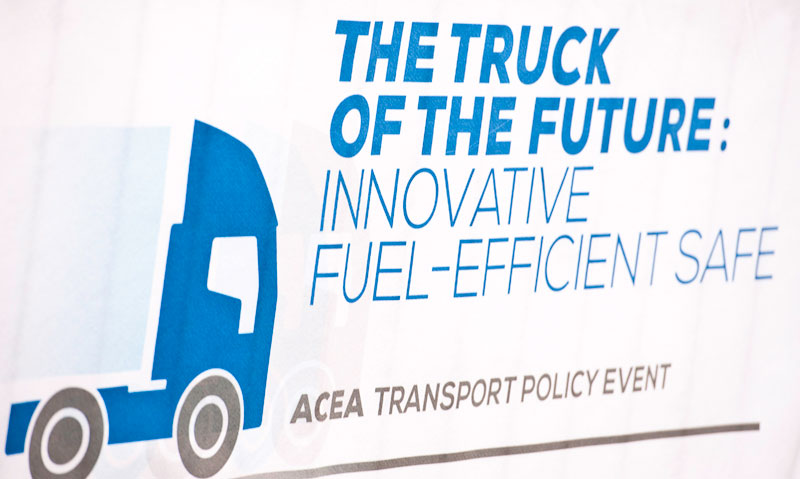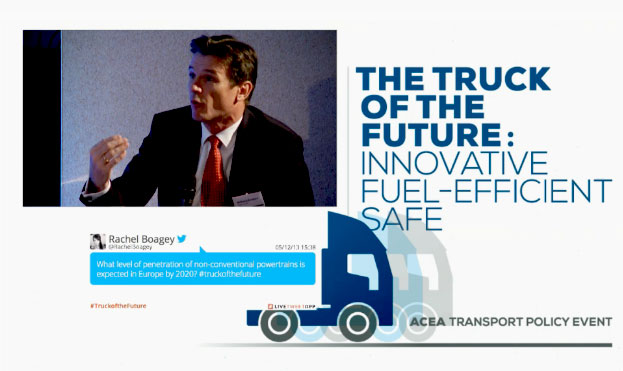An ACEA Transport Policy event held by The European Automobile Manufacturers’ Association (ACEA) in Brussels this week concentrated on the importance of continued innovation amongst other factors to increase the efficiency of Europe’s commercial vehicle sector.
A panel debate featured contributors from all influential sections of the automotive industry who combined their thoughts regarding the so-called truck of the future and how to achieve it.
The truck of the future will be smarter safer and cleaner, was the consensus, following the theme of the event; this will be achieved thanks to constantly improving industry efforts and legislative advances in Europe. However, more is still needed to ensure the meeting of many future goals, including the EC-proposed 2020 target to reduce greenhouse gas emissions by 20%.
The question of finding a balance between growing transport needs and environmental protection remains, however, along with the question of how to get the truck of the future on the road.
Cindy Miller, President of UPS Europe, sat on the panel, and explained a concept called ‘constructively dissatisfied,’ a belief of UPS that dissatisfaction with the current state of the commercial vehicle sector is what leads to positive changes. Miller commented, “We believe that something can always be done better tomorrow. Do we have the truck of the future at this moment? No. Has UPS perfected the supply chain? No.”
The concept of constructive dissatisfaction was also backed by Wolfgang Bernhard, Chairman of ACEA Commercial Vehicle Board and Chief Executive of Daimler Trucks, who said, “We are also constructively critical of the industry. Where we are right now represents the state-of-the-art today, but in the future we have something different in mind. The whole economic organisation in Europe is completely dependent on the truck and it is in the interest of Europe that each and every truck is as smart and efficient as possible.”

Leader of the pack
Of course, these changes can only take place with the constructive work of all influential parties, including policy-makers. The panel agreed that as long as policy and industry experts continue to work together, discussion will continue to drive the industry. Miller continued, “Europe leads the rest of the world in this and now we need to find the next best thing to move tomorrow forward.”
ACEA’s Bernhard agreed with Miller, saying, “We are paving the way for the world. China adopts European standards, and this can also be seen in other countries such as Brazil, which is moving from Euro IV to V. Everyone is embracing emission standards that we put out.”
Although Bernhard sees this as a positive, he mentioned how standards and harmonisation could help boost the journey towards lower emissions and higher standards within the commercial vehicle industry. He said, “The countries that adopt different standards are America and Japan, but it would be desirable to have a mutual recognition of those things.”
He continued, “Harmonising is not going to happen any time soon, as everyone has to put their egos into the dock, but we need standards. This doesn’t just apply to trucks but cars, and we are trying to figure out what could be a blueprint for the world.”

Safety matters
The methods taken to achieve this goal can be achieved in many different ways, such as improving the aerodynamics of trucks to increase efficiency. Although a maximum currently exists on the dimensions of trucks, an allowance of additional flexibility would enable improvements on the aerodynamic profiling, fuel consumption and operating costs.
Safety considerations of the truck of the future are also important. Representatives of road users and environmental issues have drawn attention to the potential for future safety improvements that could also improve a truck’s fuel economy. Bernhard said, “Technology has endless possibilities and is performing well, but there are also elements related to the design which can provide alternatives. You can improve the field of vision for drivers and build in various safety features.”
Optimising the truck involves enhancing every part of the vehicle to benefit the overall efficiency of the vehicle, and of the industry. However, Bernhard stated that is it also vital to concentrate on what can be done here and now, rather than dwelling on possible future aerodynamic improvements. He explained, “We want to concentrate on the rear of the trucks, where not much has been done so far – this is where the biggest opportunity is. The rear is open for interpretation and innovation and in short periods of time we can achieve great things. This is stuff we can do immediately.”
Bernhard made clear that while this method is not desirable for the long term, for now, it can make a big difference to the overall efficiency. The same goes for fuel efficiency improvements, which can begin to be made in the short-term. Bernhard explained that by making these changes, the fuel efficiency of each truck can be improved by 2%. “There is still room for improvement here and this is not a forever answer. If I had the choice right now, I would make these changes. The front of the truck can be changed in the long term but the rear is the priority at this moment in time. If we want to move on towards the CO2 target, we have to put these things into the picture again.”
Reducing emissions
Companies such as UPS are often regarded as part of the problem when it comes to emissions, but Miller touched on the achievements that can be made in the future in these areas. She stated, “I believe the appetite has opened for collaboration and I’m very encouraged. Companies such as UPS are part of the solution not the problem the mission to decrease emissions. The more companies like us we move forward, the more everyone else will benefit.” However, Miller does believe there is more to be done, commenting, “All areas of CO2 emissions have been decreasing apart from that of transport. What we try to do is tackle the vehicle from a European perspective and work on how to make it more efficient.”
The prospect of autonomy and electrification
As well as increasingly stringent emission regulations in Europe and around the world, autonomous and electric trucks are both current considerations which would work towards the truck of the future. For this to happen, however, road charging, similar to emissions regulations, would have to become more harmonised. Road charging is a live issue and every member state is faced with the same challenges. The obstacles lie with how to not only build charging infrastructure but also to ensure its maintenance.
Bernhard said, “We need to take a big look at it and make sure funds are used. Maybe some of the infrastructure can help push the design and future possibilities to greater heights. The problem doesn’t just lie with the infrastructure but with all technology. He added, “Batteries must improve by factor 20 in order to make electric drive a game changer.”
Government
Of course, none of these changes can take place without political support from the government. “Changes are happening but they could be happening even more,” said Bernhard. “The benefits can be reaped by legislative modernisation and updating. Developments are happening in any case but present legislation puts an obstacle there.”
Miller agreed, saying, “Enforcement and upholding is a very critical point in our industry and we need a unified voice to help it to develop.”
Although the industry has come a long way in increasing the efficiency of commercial vehicles, overall, innovation has to be a coordinated effort by manufacturers, drivers and infrastructure providers to deliver the truck of the future that everyone is hoping for.
Rachel Boagey
